|
Author: William Nowlin
Source: Electronics & Wireless World, Sep 1988, Vol 94 No 1631 (pages 18-21 physical)
Two new computers have been introduced recently which use entirely new bus
structures for add-in cards. Apple Computer's Macintosh II uses a personal
computer version of the NuBus. IBM's new Personal System/2 family uses an
improved personal computer bus called the Micro Channel Architecture. This
article presents a comparison of the two buses and the two computers, and
includes a technical examination of certain measured system characteristics
using GPIB/IEEE488 boards which have been developed for both buses.
The Apple Macintosh II and the IBM Personal System/2 computers are
attracting a great deal of attention from add-in board manufacturers. The
article covers some of the technical aspects of designing cards for these
machines.
The Macintosh II is a 32-bit 68020-based computer which uses a personal
computer version of NuBus a general-purpose 32-bit computer backplane bus
conceived at MIT and developed further by Texas Instruments. At present, the
IEEE P1196 committee is formalizing the NuBus specification into a form
suitable for acceptance and publication.
The IBM PS/2 family currently consists of six computers, three of which use
the new Micro Channel Architecture (MCA). The Micro Channel is a
general-purpose computer bus which supports 8, 16, or 32-bit microprocessors,
peripherals, and memory. PS/2 Models 50 and 60 are equipped with 16bit 80286s,
and Models 70 & 80 use the 32-bit 80386. Models 50 and 60 support the
16-bit version of the MCA, and Models 70 & 80 support both 16 and 32-bit
add-in cards.
Performance Examples
The performance specifications listed in the panel are all theoretical in
nature. To determine how each bus actually performs, I examined two add-in card
examples and discuss the measurements obtained.
Table 1 gives a comparison of the two computers used: a Macintosh II
computer and a PS/2 Model 80. The Macintosh II is run by a 16MHz 68020
microprocessor and the Model 80 by a 16MHz 80386. The d.m.a. controller in the
PS/2 runs at 8MHz, while the Mac is equipped with a National Instruments
NB-DMA-8-G board containing an 82380 d.m.a. controller running at 10MHz.
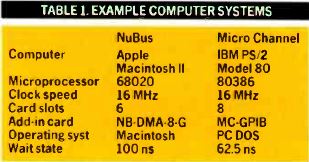
Table 1. Example computer systems
The Macintosh II has six card slots, one of which is used by a display
adapter and another which is occupied by the NB-DMA-8-G card. The Model 80 has
eight slots, with one taken up by a disc controller and a second slot used by
National Instrument's MC-GPIB card.
The Macintosh II runs the Macintosh operating system and the Model 80 runs
PC DOS3.3. Slave cards on the Macintosh II can introduce wait states of 100ns
each, and on the Model 80 each wait state adds an additional 62.5ns to the
transfer.
The NB-DMA-8-G, in addition to its 82380 d.m.a.c. and bus master circuitry,
has an IEEE488 interface which responds as a NuBus slave. The measurements
described use the NB-DMA-8-G both as NuBus d.m.a. master and slave.
MC-GPIB is an IEEE488 interface for the Micro Channel. It can respond as a
bus slave and also contains arbitration circuitry to allow it to be used in
conjunction with the d.m.a. controller on the mother board.
Slave Performance
In this example, I treat the NB-DMA-8-G and the MC-GPIB cards as bus slaves
and measure some of the timing parameters which are of interest and which
affect i/o performance.
A block diagram of the NB-DMA-8-C is shown alongside. For
performance testing, I had the Macintosh II's 68020 execute a simple i/o write
test. The test programs, shown on this page, transfer
data to and from the 16×16 bit, fifo memory in the Turbo 488 integrated
circuit on the card.
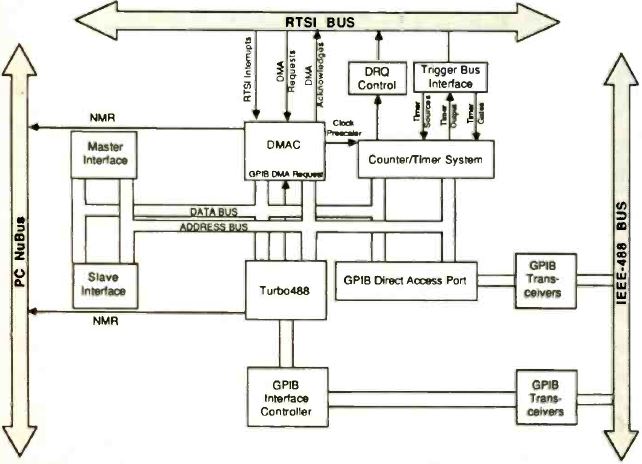
The same test was performed on the PS/2 Model 80 using the
code shown. A block diagram of the MC-GPIB
card, right, identifies the Turbo 488 and circuitry that perform slave
functions which are quite similar to those on the NB-DMA-8-G.
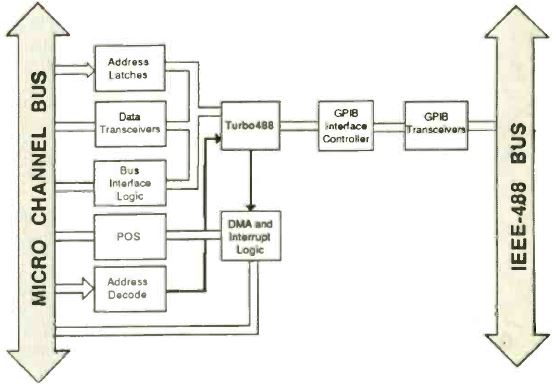
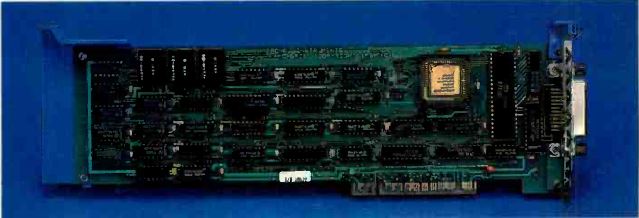
The two boards and computers compared in these tests are
National Instrument's MC-GPIB interface for the IBM PS/2, and the NB-DMA-8G
combined d.m.a. controller and 488 interface.
Table 2 gives a summary of the performance obtained using the test
programs and the two different systems. The fifo read and write cycle times are
theoretical best-case values. Note that the NB-DMA-8-G adds 200ns to the
fastest possible transfer cycle on the NuBus. This extra delay is due to fifo
synchronization arbitration and access time. Similarly, the MC-GPIB adds
approximately 125ns to the minimum Micro Channel cycle. These delays establish
maximum theoretical transfer rates of 2.5×106 16-bit transfers
per second (5Mbyte/s) for the NB-DMA-8-G and 2.67×106 16-bit
transfers per second (5.3Mbyte/s) for the MC-GPIB.
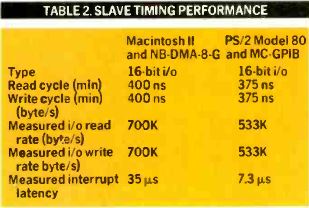
Table 2. Slave timing performance
The actual programmed i/o rates obtained using the i/o read and write test
programs are 0.7Mbyte/s for the NB-DMA-8-G and 0.533Mbyte/s for the MC-GPIB. As
you can see, bus speed is of less importance in this example than
microprocessor performance (execution time, program memory speed, on-chip
cache, instruction set, etc).
One final slave timing characteristic was measured for both systems:
interrupt response time. For this test, the time between when the card
generated the interrupt request on the bus to when the interrupt service
routine was entered when measured.
The 35µs interrupt latency for the Macintosh II is indicative of the
interrupt service queue used by the Macintosh Operating System rather than
hardware performance features of the 68020. The 7µs interrupt latency for
the PS/2 Model 80 is a close indicator of actual hardware performance, since no
intervening interrupt service software overhead is incurred in PC DOS.
Bus Master Performance
To measure bus master performance and, in particular, d.m.a. performance, we
use the 82380 d.m.a.c. on the NB-DMA-8-C to transfer data to and from the
Macintosh II motherboard and the fifo on the card. For the Micro Channel, we
use the arbitration circuitry on the MC-CPIB in conjunction with the PS/2 Model
80 d.m.a.c. to transfer data to and from the motherboard memory and the fifo on
the card. The results of the test are shown in Table 3.
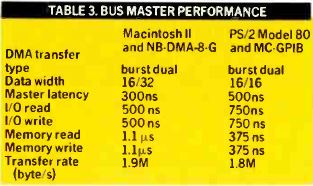
Table 3. Bus master performance
Burst mode fetch and deposit d.m.a. transfers were used on both machines.
Transfers on the NuBus were 16 bits wide for i/o accesses (fifo reads and
writes) and 32 bits wide for memory. (The 82380 automatically performs source
and destination hit width adjustments. The master latency times show how long
it took from the time the card requested use of the bus until the time it
received bus control.
The i/o read and write times indicate the time taken to access the fifo by
the d.m.a. controller. The memory read and write times show how long it took
for the d.m.a. controller to access system motherboard ram. Note that it should
he possible to substantially increase the performance of the Macintosh II in
this example by using a high-speed ram. PC-style NuBus add-in card.
The data transfer rates are given last. The Macintosh II is able to overcome
its relatively slow memory access time by transferring 32 bits as opposed to 16
bits on PS/2.
Results
Both machines provide powerful platforms for add-in i/o cards, and both have
distinct advantages and disadvantages, as well as unique characteristics. Some
of the features that are common to the Macintosh II and the PS/2 Model 80 are
high speed. 32-bit microprocessor, memory, and bus: automatic card
configuration at power on (no jumpers): powerful interrupt mechanism: and
support for multiple add-in cards. Some of the dissimilar features are listed
in Table 4.
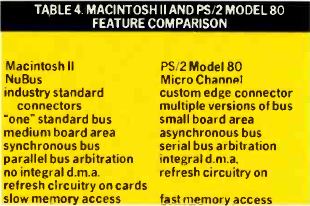
Table 4. Macintosh II and PS/2 Model 80 feature
comparison
I feel that the 96-pin DIN connector used by the PC-style NuBus cards offers
advantages over the edge fingers defined by the Micro Channel Architecture,
primarily in terms of mechanical reliability.
The multiple versions of the Micro Channel make it more difficult to develop
add-in cards that can be used on all machines and at the same time offer
maximum performance. For example, if you were developing a high performance,
intelligent peripheral processor card for the Micro Channel, you may be forced
into developing two versions: one with a 16-bit interface and one with 32-bit
interface.
The small board area available on Micro Channel cards makes development more
difficult. In many cases, the developer will be forced into designs which
require gate arrays or other asics and/or surface-mounted components. Both of
these solutions lengthen development time and, except in very high volume
cases, increase manufacturing costs.
At National Instruments, it is easier to design for the NuBus because of its
synchronous nature. The separate address and data lines on the Micro Channel do
not turn out to be of advantage because timing requirements force addresses to
be latched much in the same way that they are latched on NuBus
implementations.
Although I don't have quantitative, measured data to support this next
conclusion, it is obvious that a portion of the Micro Channel bus bandwidth is
utilized by the arbitration process, and that the percentage used increases as
more devices contend for the bus. Unlike the Micro Channel, NuBus arbitration
occurs in parallel with normal bus traffic.
For i/o intensive applications involving large blocks of data, I feel that
it is essential for the computer system to provide d.m.a. transfer capability.
The Macintosh II requires that this capability be provided by the add-in
cards, themselves. The PS/2 uses a clever scheme which allows cards to use a
d.m.a.c. on the motherboard. Unfortunately, the one on the PS/2 Model 80 is
limited to 16-bit transfers. Perhaps future members of the PS/2 family will
offer full 32-bit support.
The Micro Channel provides refresh support for dynamic ram, add-in cards.
This eliminates the expense of refresh circuitry on each ram card. It does,
however, utilize bus bandwidth (less than 5% on the PS/2 Model 80). This
characteristic is probably paralleled on the NuBus, however, by increased
access times during memory refresh and bus access collisions.
Accessing the Macintosh II motherboard ram from an add-in master NuBus card
is agonizingly slow by today's standards. The PS/2 family offers acceptable
access to its motherboard memory. Perhaps future versions of the Macintosh II
will correct this deficiency.
Comparative Overview
The table lists some of the primary features of the PC-style NuBus
and the Micro Channel bus. The NuBus is considered a synchronous bus. All bus
transactions are referenced to a single, 10MHz clock signal. Transactions on
the Micro Channel bus are asynchronous and are not referenced to a specific
clock signal.
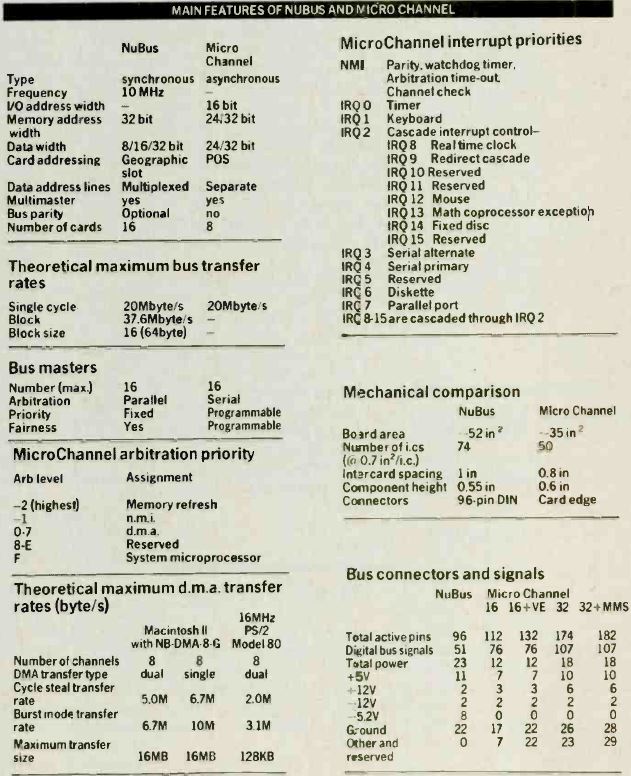
Main features of NuBus and Micro Channel
The 10MHz + 0.01% clock on the NuBus has an unequal duty cycle of 25:75. The
Micro Channel bus provides a 14.31818MHz + 0.01% clock signal but does not use
it for bus timing.
Micro Channel Architecture provides for separate memory and i/o address
spaces while NuBus provides for a single address space. I/O addresses on the
Micro Channel are 16-bits wide, providing 64K bytes of i/o address space.
Memory addresses on the NuBus are 32-bits wide and allow up to 4Gbytes of
ram or rom to be individually addressed. The 16-bit version of the Micro
Channel uses a 24-bit memory address, which translates to 16Mbytes; the 32-bit
version provides a full 32-bit, 4Gbyte memory address space.
Data can be transferred on the NuBus as bytes, 16-bit halfwords, or 32-bit
words. The 16-bit version of the Micro Channel can transfer 8 or 16-bit data,
while the 32-bit version can handle 8, 16, 24 and 32-bit data. Bit, byte,
halfword, and word significance is the same on both the NuBus and the Micro
Channel.
On the NuBus, cards are given 1/16th of the total 4Gbyte address space
1256Mbyte). NuBus allows up to 16 cards in a system and each card is given
1/16th of the total 256M card address space (16Mbyte per card). The card
automatically assumes its proper address by sampling four signals on the NuBus
connector which provide a card identification code.
Micro Channel cards use the Programmable Option Select (POS) feature to
determine i/o addresses. Add-in card address information is stored in a
non-volatile r.a.m. available to the microprocessor. At power-on-time, the
microprocessor reads the address information from the n.v.r.a.m. and configures
each card in the system. Using the POS mechanism, add-in cards may occupy any
free portion of the available memory or i/o address space.
Data transfers. A minimum single data transfer on the NuBus consists
of two clock cycles (a start cycle and an acknowledge cycle, of 200ns, which
translates to a 20Mbyte/s transfer rate see Tables. The Micro Channel minimum
cycle is 200ns, which, for 32-bit data transfers, translates to 20Mbyte/s. The
10MHz 80286 microprocessors used in the PS/2 Models 50 and 60 support a minimum
cycle of 300ns, which translates to 6.7Mbyte/s. The 16MHz 80386 Models 70 &
80 have a minimum cycle of 250ns, or 16Mbyte/s. The higher performance
20MHz 80386 version will be able to support the full 20Mbyte/s transfer rate of
the Micro Channel.
Bus masters. NuBus arbitration priority is fixed and depends on the
card slot ID, with slot number 15 having the highest priority. Figure 1
shows the relationship of the NuBus slot IDs for the Macintosh II. The Micro
Channel defines 18 levels of fixed priority, see Table 3. The
arbitration level used by an add-in card is normally controlled by a
Programmable Option Select register on the card which allows a limited form of
programmable priority.
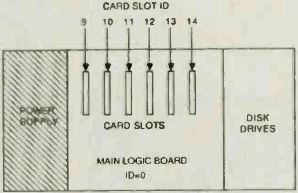
Figure 1: NuBus Slot IDs
DMA transfers. The Micro Channel computers are equipped with an
eight-channel d.m.a. controller. Add-in cards can use the d.m.a. controller to
perform data transfers using the standard Micro Channel bus arbitration
mechanism. The d.m.a. controller on PS/2 Models 50 and 60 runs with a 10MHz
clock, and the 16MHz Model 60 (???) d.m.a.c. runs at 8MHz.
The Macintosh II does not provide a d.m.a. controller on the backplane. For
d.m.a. comparison, we used the NB-DMA-8-G card, Figure 2. This provides
the Macintosh II with a general-purpose d.m.a. controller for the PC-style
NuBus in addition to a 488 bus interface. It uses an Intel 82380 controller
running at 10MHz.
An analysis of the d.m.a. capabilities of the Macintosh II equipped with an
NB-DMA-8-G card as compared to a 16MHz IBM PS/2 Model 80 with built-in d.m.a.
controller is shown in Table 3. The analysis is theoretical and assumes
best-case conditions.
Each configuration can support eight independent channels. The 82380 on the
NB-DMA-8-G can perform 8, 16, or 32-bit data transfers; the PS/2 Model 80 can
perform 8 or 16-bit transfers. The Model 80 d.m.a.c. transfers data using a
fetch and deposit technique, called flow-through or dual-addressing. The 82380
normally uses the same fetch and deposit method, but can also support single
address or flyby d.m.a. transfers.
For this theoretical analysis, I assumed that the data transfers can be
performed in the minimum time possible; for both Micro Channel and NuBus.
Burst capabilities allow the d.m.a.c. to keep the bus as long as necessary.
Assuming that no higher-priority master is using the NuBus, we can determine
the maximum transfer rate obtainable using burst mode. For the NB-DMA-8-G, this
time is 600ns per 32-bit fetch and deposit cycle 16.67Mbyte/s) and 400ns per
32-bit flyby cycle (10Mbyte/s).
On the PS/2 Model 80, the memory refresh arbitration level will override any
burst transfer in progress. Since a memory refresh takes place an average of
once every 15.8µs, this will limit the number of 16-bit fetch and deposit
transfers that can be performed during a burst to 25. Using this fact, the
maximum burst data transfer rate that can be achieved is 3.1Mbyte/s.
The 82380 d.m.a.c. on the NB-DMA-8-C is equipped with a 24-bit transfer
counter, allowing it to transfer a maximum of 16Mbyte/s with one d.m.a.
transfer operation.
The custom d.m.a.c. on the PS/2 Model 80, and on Models 50 and 60, contains
a 16-bit transfer counter, providing the ability to transfer 64K 16-bit words
(128K bytes) or 64K bytes with a single d.m.a. operation.
Interrupts. The PC-style NuBus provides an interrupt request signal
for slave cards called non-master requests, or NMRQ. As implemented on the
Macintosh II, each card generates a separate interrupt request signal to the
68020 microprocessor on the motherboard. Each slot's interrupt has a
programmable priority. Interrupts on the Macintosh II are level sensitive as
opposed to edge sensitive.
The Micro Channel implements a shareable, level-sensitive, multiple-line
interrupt mechanism. A total of 11 shareable interrupt lines are available on
the bus. Priorities are shown in the Table.
Test Programs
Macintosh II I/O Write Test Source Code
code test-write
move.l #$50, d1
move.l #fifo_addr, a1
move.l #buf_addr, a0
move.l #isr3_addr, a2
move.l #3, d0
loop btst d0, (a2)
beq finis
move.w (a0)+, (a1)
dbne d0, loop
finis rts
end-code
Macintosh II I/O Read Test Source Code
code test-read
move.l #$50, d1
move.l #fifo_addr, a1
move.l #buf_addr, a0
move.l #isr3_addr, a2
move.l #2, d0
loop btst d0, (a2)
beq finis
move.w (a1), (a0)+
dbne d0, loop
finis rts
end-code
PS/2 Model 80 I/O Write Test Source Code
.286c
public _fillfifo
_TEXT segment byte public 'CODE'
assume cs:_TEXT
xx proc near
_fillfifo:
push ax
push dx
push cx
push bx
push si
mov si, 0ff00H
mov bx, 0fe1aH
mov cx, 20H
L2: mov dx, bx
L1: in ax, dx
test ax, 8
jz L3
mov dx, 0fe18H
outs dx, word ptr ds:[si]
loop L2
L3: pop si
pop bx
pop cx
pop dx
pop ax
ret
xx endp
_TEXT ends
end
PS/2 Model 80 I/O Read Test Source Code
.286c
public _fillfifo
_TEXT segment byte public 'CODE'
assume cs:_TEXT
xx proc near
_fillfifo:
push ax
push dx
push cx
push bx
push si
mov si, 0ff00H
mov bx, 0fe1aH
mov cx, 20H
L2: mov dx, bx
L1: in ax, dx
test ax, 4
jz L3
mov dx, 0fe18H
insw dx, word ptr ds:[si]
loop L2
L3: pop si
pop bx
pop cx
pop dx
pop ax
ret
xx endp
_TEXT ends
end
William Nowlin is engineering vice-president with National Instruments
Corporation. Austin. Texas, represented in the UK by Amplicon
Electronics.
|